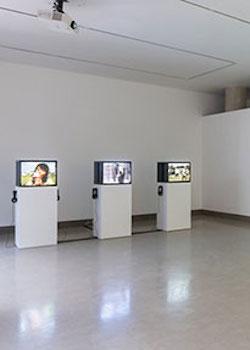Shapeshifter

Exhibition by Yamashiro Chikako
White Rainbow
15 March – 28 April 2018
Review by Silvia Caso
Okinawa is the largest of the Okinawa Islands, which are part of the Nansei (also referred to as Ryukyu) island group in Southern Japan. Since the end of World War II, several islands of the archipelago have been hosting US military bases. Their presence especially concerns the main island of Okinawa; despite being reverted to Japanese authority in 1972, more than a 20% of its territory is still occupied by airbases of the United States Forces Japan. Across the years, the presence of American soldiers has given rise to three major waves of mass protest, in what scholars have referred to as the “Okinawan struggle”.
This forced cohabitation, very unwelcomed by the Okinawans, is the main preoccupation of Yamashiro Chikako’s work, on show under the title of Shapeshifter at White Rainbow’s non-profit space in London until the 28th of April. Born in Okinawa in 1976, Yamashiro has witnessed the last public outcry in the “Okinawan struggle” caused by the rape of a local schoolgirl by American soldiers in 1995.
Leaving behind White Rainbow’s dark glass façade and entering the space, a large screen is playing a movie with an intense in- and out-of-the-water camera movement; the installation is accompanied by loud gurgling sounds. The protagonist is a barely-floating, frantically-breathing fictional mermaid, witnessing fishing boat trips, soldiers’ maritime activities, protesters lining up on the seashore in Henoko. Once famous for its coral, Henoko has been recently rebuilt to allow the relocation of a military base, a governmental choice that has inflamed the protests of activists and citizens alike.
Using the mermaid as a neutral standpoint, Yamashiro chooses to approach the debate on reconstruction diffusing the space between the binary constructions of “us” versus “them”. To reinforce the “outersideness” of the artist, on the right-hand side of the screen Millaisesque photographs portrait Yamashiro as the mermaid herself, an open-eyed Ophelia immersed in a water stream, with her mouth covered by seaweed. The pre-Raphaelite undertones exuding from these self-portraits seem to hint to the formative practice of Yamashiro, who graduated with a major in painting.
Across the room, three video installations compose the work titled OKINAWA TOURIST, which takes its name from the major tour operator of the island. In I Like Okinawa Sweet Yamashiro is devouring an ice-cream with gusto; in Trip to Japan she is offering facts as population, climate, geology of Okinawa, as if delivering a sightseeing tour. Lastly, in Graveyard Eisa the artist and her clique stage the evocative Eisa, the island’s traditional dance performed during summer festivals.
A casual observation of these video performances might suggest that Yamashiro is operating a not-too-subtle mockery of local traditions; however, the locations chosen for each of the depicted activities are carefully balanced to suggest a sense of displacement. The fence of a military airport base becomes the best place where to savour ice-cream; holding a sign while standing in front of a government building is an acceptable option for a tour operator; and Eisa dances are now meant to take place in a graveyard. Within these works, the artist seems to firmly reposition herself on the side of her fellow countrymen, left without a land to claim as their own, and having to negotiate their space in a territory that originally belonged to them.
The most impressive video piece is screened at the back of the gallery, in White Rainbow’s newly built-in cinema. Walking into the pitch dark room mid-screening, the overwhelmingly aggressive noise of a military aircraft is soon replaced by the silence accompanying impressive aerial views of rice fields. The vibrant greenery of the beautiful landscape is interspersed with the views of someone moving through dark tunnels of rocks. Eventually, the scene moves to an extreme close-up of mud-encrusted eyes and fingers. Unravelling their arms and legs from a network of intertwined limbs, opening their glassy eyes, men and women covered in mud emerge from a human mud-slide that has taken over a whole field. The continue change of camera angle is disorientating, with grand angles on the vastness of the space juxtaposed to abrupt zooms on dirty limbs and eyelashes.
The piece, aptly called Mud Man, has been filmed between Okinawa and Jeju in South Korea: the whispering sounds that can be occasionally heard in the background are either of the two languages, softly dispersed into thin air by murmurs emitted by these mud men. As the Korean-Japanese relationships have been tainted by a past history of colonialism, the use of this second filming location recalls an element of duality on the role of victims and perpetrators Japanese people have assumed in the generic discourse of land appropriation.
Leaving the exhibition, we are left wondering if Yamashiro’s work could be ascribed to a certain cultural perspective of the “artist as ethnographer”, as theorised (in shape of a question) by Hal Foster in 1995. The unexpressed questions raised by these mud men remain unanswered: are we aware of the space we occupy? Are we fighting enough to recover our voice and to re-establish our presence in open air, from where we can see and be seen? Skilfully, Yamashiro has indeed shifted the inner structure of these questions, weaving the narrative of an identity crisis into an act of resistance towards political and power constructs that have no interest in the future of Okinawans.
Editor’s Note: The art space White Rainbow reopened in March 2018 with a new 12 month programme of solo exhibitions and projects by contemporary Japanese artists Chim↑Pom, Sasamoto Aki, Izumi Taro, Koizumi Meiro and Katayama Mari. More information on future exhibitions here.

